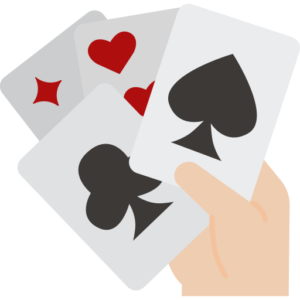Glossary Term
Big Blind
Big Blind
Used In: Poker
Introduction
The big blind is a forced bet in poker, typically used in games like Texas Hold'em and Omaha. It is posted by the player sitting two seats to the left of the dealer. The big blind helps initiate action in a hand by ensuring there is already money in the pot before the players receive their cards. The size of the big blind is usually set by the game's betting structure and can vary depending on the game being played.
In most games, the big blind is double the size of the small blind, which is placed by the player to the immediate left of the dealer. The blinds rotate around the table after each hand, so every player will take turns posting the big blind. This system forces players to remain active in the game, as they are required to make decisions based on the initial blind amounts, even if they have weak hands.
The big blind plays a key role in poker strategy, as players often need to decide whether to fold, call, or raise based on their hand and the action from other players. It creates an incentive for players to stay in the game, making the betting more dynamic and engaging. Understanding the big blind and its impact on your decisions can be crucial to mastering poker.
In Depth Look
The big blind is one of the two mandatory forced bets in poker, placed by the player two seats to the left of the dealer. It serves to create an initial pot and encourages players to engage with the game right from the start. The size of the big blind is determined by the game's betting structure, with the amount typically being twice the value of the small blind, which is posted by the player immediately to the left of the dealer. As the big blind rotates around the table after each hand, every player takes turns contributing to the pot. This ensures that all players, regardless of their position, participate in the game’s flow and are forced to make decisions based on their hand strength and the current size of the pot.
Strategically, the big blind is a critical aspect of poker gameplay. When a player posts the big blind, they are essentially committing a certain amount of chips to the pot before seeing their cards. This means that the player will often have to play with less information than others who act after the blinds are posted. Players in the big blind position may have the option to check, raise, or fold when the betting round begins, depending on the strength of their hand and the actions of other players.
Players in this position are often offered the best odds to continue in the hand since they have already invested chips in the pot, making it more attractive to see the next community card at a lower cost.
Mechanics
The mechanics of the big blind in poker are simple but crucial to the structure of the game. At the start of each hand, the player to the left of the dealer posts the small blind, and the player two seats to the left posts the big blind. These forced bets are placed before any cards are dealt, ensuring that there is money in the pot and that the game remains competitive. Once the blinds are posted, the dealer deals the hole cards to each player, starting with the player to their left. The first round of betting begins, with the player directly to the left of the big blind acting first. From there, players can either call the big blind, raise, or fold, depending on their hand and the actions of the other players.
After the first round of betting, the dealer reveals the community cards (flop, turn, and river), and additional rounds of betting follow. The big blind player, having already committed chips to the pot, is in a unique position—they are the last to act in the pre-flop round but are often the first to act in the later betting rounds, which can influence their decisions. The big blind's contribution remains in the pot even if the player folds, but if the hand continues, the player is still in the game and has a chance to win the pot. The big blind is essential for maintaining game flow, as it ensures players are actively participating and prevents the game from stalling.


Illustrated Example
Let’s break down an example of the big blind in action in a typical poker game. Suppose you are playing a Texas Hold'em game with 6 players at the table. The small blind is $1, and the big blind is $2. The player to the immediate left of the dealer posts the small blind, and the player two seats to the left posts the big blind. The dealer then deals two hole cards to each player. The first round of betting begins, starting with the player directly to the left of the big blind. The options are to fold, call the big blind, or raise.
For this example, let’s say the player in the big blind has a hand of 7♠ 5♣. The player to their left raises to $6, and the big blind player decides to call the $6. This means the big blind player puts an additional $4 into the pot, making their total bet $6 (the initial $2 big blind plus the $4 call). Here’s what the situation looks like in a table format:
| Player | Action | Amount in Pot |
|---|---|---|
| Player 1 (SB) | Fold | $1 |
| Player 2 (BB) | Call $4 | $6 (Total: $2 BB + $4 call) |
| Player 3 | Raise to $6 | $6 |
| Player 4 | Fold | $0 |
| Player 5 | Fold | $0 |
| Player 6 | Fold | $0 |
Player Perspective
Being in the big blind position comes with both advantages and disadvantages. On the positive side, the big blind is the last player to act during the pre-flop betting round, allowing them to see how other players have responded before making a decision. This can offer valuable insight into the strength of their opponents' hands. Since the big blind has already committed chips to the pot, they are often more inclined to continue playing, especially with hands that have decent potential but aren't necessarily strong enough to raise. However, this commitment to the pot can sometimes lead to players staying in hands longer than they should, especially if they don't adjust their strategy accordingly.
On the downside, the big blind position often requires players to act first in subsequent betting rounds, which can be a disadvantage if other players are aggressive. After the community cards are revealed, the big blind player must decide whether to bet, check, or fold without knowing how others will act. Additionally, since they are committed to the pot, players in the big blind may feel obligated to continue, even when they have a weak hand. This can lead to losing chips if they don't evaluate the situation carefully. Overall, the key to playing the big blind effectively is to assess the strength of your hand, consider your position relative to other players, and adjust your strategy based on the actions of others at the table.
Conclusion
While it forces players to commit chips before seeing their cards, it also provides the opportunity to play hands with favorable pot odds. Understanding the dynamics of the big blind position can help players make better decisions, whether by folding weak hands early or playing more aggressively with strong hands. Like all aspects of poker, success with the big blind comes down to knowing when to act and adjusting to the actions of other players at the table.
The Top Online Casinos for Playing Poker
These platforms prioritize player satisfaction by providing intuitive interfaces, seamless gameplay experiences, and robust security measures to ensure a fair and enjoyable environment for all users.
welcome bonus
Welcome package €1,500 + 350 Free Spins
35x wagering (Deposit & Bonus)
Top 5 best casinos
$titl$ is not the Best Choice. Here are some better options:


Author
Branimir Ivanov | Senior News Contributor









